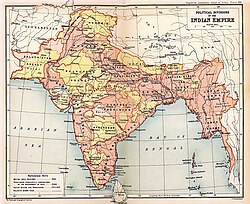| Colonial India | ||||||||||||||
|---|---|---|---|---|---|---|---|---|---|---|---|---|---|---|
 | ||||||||||||||
| ||||||||||||||
| ||||||||||||||
| ||||||||||||||

The divisions of British India were the administrative divisions of the Government of the British Raj or the Indian Empire. [1]
Contents
- Divisions in Bengal
- Divisions of Eastern Bengal and Assam
- Divisions in Baroda
- Divisions in Bombay
- Divisions in Burma
- Divisions in Central India
- Divisions in Central Provinces and Berar
- Divisions of Hyderabad
- Divisions in Rajputana
- Divisions in United Provinces
- Divisions in Punjab
- See also
- References
- External links